All about eye nuts
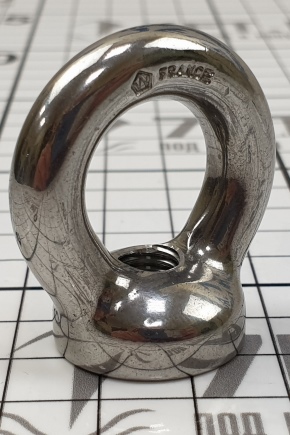
In order to be able to tighten the screw connection more firmly, the leverage has been increased. This was done using a ring attached to a traditional nut. This idea arose for the first time abroad, now it is widespread in Russia, it is widely used in many areas - in everyday life, in industry, in mechanical engineering. The article will talk about eye nuts.
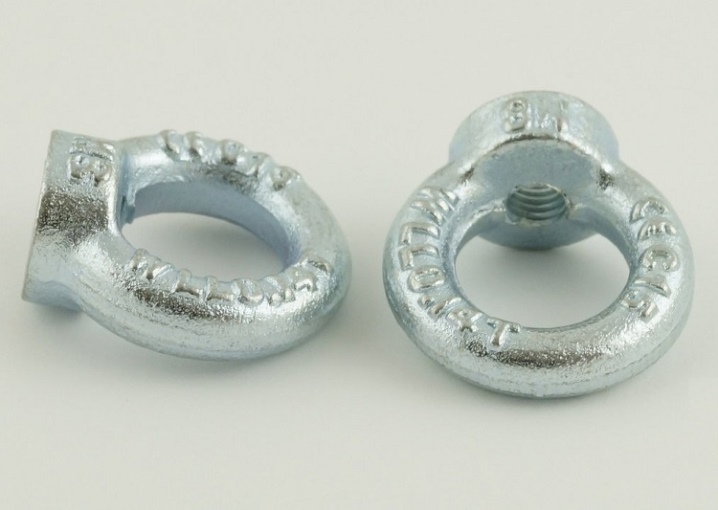
What it is?
On the territory of Russia, there are no GOST standards for the eye nut, it is produced according to DIN582. This is the world standard.
The traditional nut is a female threaded fastener. The connection is made in combination with screw bolts or studs. The prefix "eye" is translated as "ring". That is, an eye nut is a ring connected to a nut. Its main feature is the thread located at an angle of 90 degrees relative to its ring. Threads can be metric or imperial.
Here are the main advantages of such fasteners.
- No need for a wrench to tighten the hardware... This can be done using any lever inserted into the ring.
- Technological characteristics according to the international standard are very high - steel nut withstands heavy load. And also the products have an increased carrying capacity - up to 21,600 kilograms.
- Resistant to rusting in high humidity conditions.
- Low price.
The unusual shape of the hardware allows you to screw the eye nut very tightly, unlike the usual one, where it is necessary to use a wrench.
For each dimension there is also a certain carrying capacity, which will be reduced by 100 kilograms if the load is located at an angle of 45 degrees.
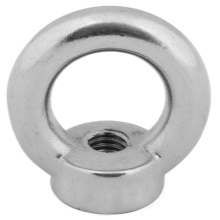
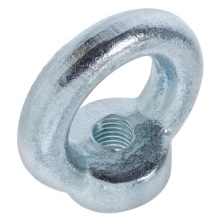
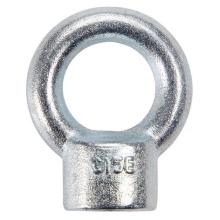
What are they made of?
According to the international standard, eye nuts must be made of durable materials:
- carbon steel grades C1030 and C1045;
- stainless or high-alloy steel grades 304 (A2) and 316 (A4);
- if these are non-ferrous alloys or metals, brass, silicon bronze, titanium and aluminum are suitable.
Fasteners, which are made from steels of standard grades, must be covered with an anti-corrosion coating. This can be hot-dip galvanized, anodizing for aluminum hardware, or bluing, also known as blackening or oxidation.
What kind of performance the fastener will have depends on how it was manufactured - it can be casting / forging or stamping. The hot stamping method is more popular: a mold is installed in the press, in which the workpiece is already located. The material is "squeezed" under high pressure. To improve technical characteristics and increase the service life, the part is coated with a layer of zinc or tin. After the nut is ready, it is cleaned of dirt and scale. The forging method is not as popular as it is too expensive and time consuming.
But hardware made using this technology is distinguished by increased strength.
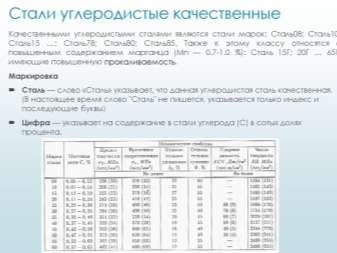
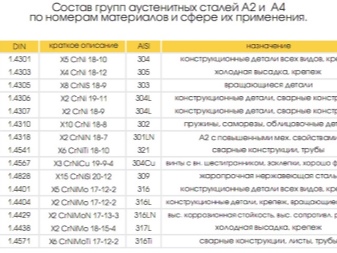
Appointment
The eye-nut is intended for lifting various overall structures, holding objects in weight, moving structures, for cargo transportation or rigging.
And also this hardware has a fairly wide scope of application. They are used:
- in construction (most often they play a special role when performing high-rise work);
- in shipbuilding;
- in the production of vehicles (for example, with the help of such fasteners, you can tow an idle car);
- in industry;
- at home;
- in agriculture.
During operation, the fasteners are screwed onto the threaded rod of the stud or screw, the size of which must correspond to the size of the nut sleeve.
If the end of the fastener is larger, you can put a special gasket or washer, the thickness of which should be more than 1 millimeter.
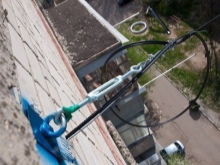
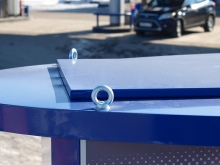
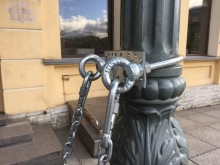
Classification
The dimensions of the nuts are also set according to DIN582 standards.
The side of the ring of the eye nut is marked with information on dimensions, material and manufacturer.
The size of the threaded surface varies and can be M6, M8, M10, M12, M16, M18, M20, M24, M26, M30, M36, from M42 to M48. They also produce hardware of non-standard sizes, for example, M4, M5, M7, M22, M27, M33, M39, M39x2, M100. According to DIN, such parameters are not recommended to be manufactured, and they can only be purchased on order. The most common are hardware with sizes M8-M16.
And also nuts are classified:
- by the type of ring - round, oval or rounded rectangle;
- by sleeve size - low or high (elongated);
- by load - non-power and power;
- by thread type - with a fine metric thread, that is, when the size is indicated in millimeters, or with an inch thread, respectively, here the size will be in inches.
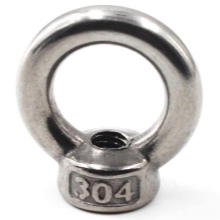

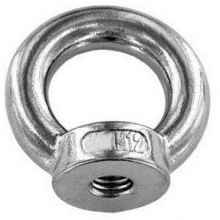
The inch dimension first began to gain popularity in the United States and Great Britain, while the metric system was common in Europe and Asia. Accordingly, there was a problem with the compatibility of various kinds of fasteners. In the future, Great Britain adopted the metric measurement, abandoning the inch.
In appearance, it is impossible to distinguish the American thread measurement system from the metric one, since their profile angle is identical - 60 degrees. It is possible to distinguish by marking: in the metric system, the strength class is indicated by numbers, in the inch system - by lines. Fasteners with different types of threads will never be interchangeable, since when screwing, a gap or gap is formed in the structure. The only difficulty that arises during the installation of the eye nut is the correct connection of the two elements.
By the type of the eye-nut head, it can be of three modifications:
- A - head in the form of a loop;
- B - power option, enlarged head;
- D - reduced head.
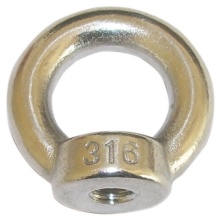
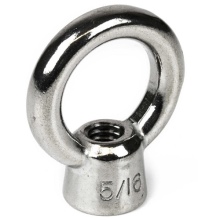
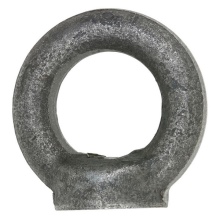
By the size of the diameter of the ring, or by its thickness
Some fasteners have a pivot hinge that will pivot in the direction of the load, and a weld-on hinge on ball bearings - here it will rotate 360 degrees in all directions. They are made of stainless steel, later covered with paint.
Important! According to the international standard, for eye nuts, not the ultimate, but the breaking load is established, that is, when irreversible changes begin to occur with the part. These are two different definitions, so when selected, the load capacity is reduced by 60%.
When choosing an eye nut, you need to take into account the area in which it will be used, and for how long, how much weight the cargo will have, what safety rules are provided.
It is advisable to purchase a nut together with a screw or stud, in order to check the size and pitch of the thread - correctly selected fasteners will make the structure or mechanism reliable and durable. Their strength should also be identical, but higher strength of the nut is allowed, but not vice versa. If the stud is stronger during tightening, the threads of the eye nut may break. It is worth remembering that damage to the rod is easy to identify, since the rupture occurs abruptly and is difficult to miss. And with the nut, the opposite is true - the stripped thread is almost impossible to see.
And also if a washer or a gasket was used in the connection, its hardness must also be taken into account, since the profile of the nut after a certain amount of time will begin to push the washer.
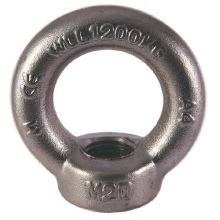
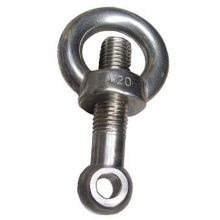
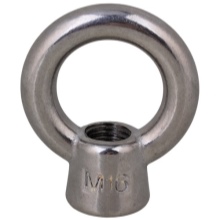
This fastener is very popular and widespread in many areas, therefore, when choosing and operating, you need to remember a few rules:
- no deformations on the nut itself and defects on the ring are allowed;
- the used fasteners must be solid, the welding of various damages is unacceptable;
- the parameters of the size of the threaded part depend on the weight of the structure to be lifted;
- the surface of the hardware must be cleaned of dirt, shavings, scale;
- lifting the load, its movement should occur evenly and without sudden movements;
- after unscrewing the nut, its appearance should remain unchanged, that is, there should be no cracks, breaks, bent parts and other deformations;
- the angle between the bushing of the fastener and the sling should not exceed 45 degrees;
- the axis of the sling should be located in the plane of the ring;
- the temperature regime for nuts is very wide - operation is possible both at -20 and +200 degrees Celsius;
- the choice of the manufacturer also plays an important role.


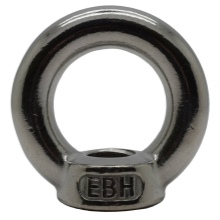
You can find out what an eye bolt and an eye nut are from the video below.













The comment was sent successfully.